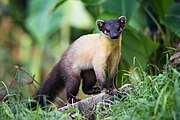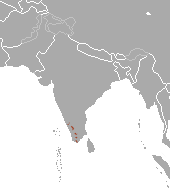
The Mustelidae are a diverse family of carnivorous mammals, including weasels, stoats, badgers, otters, martens, grisons, and wolverines. Otherwise known as mustelids, they form the largest family in the suborder Caniformia of the order Carnivora with about 66 to 70 species in nine subfamilies.

Badgers are short-legged omnivores in the family Mustelidae. Badgers are a polyphyletic rather than a natural taxonomic grouping, being united by their squat bodies and adaptions for fossorial activity. All belong to the caniform suborder of carnivoran mammals.
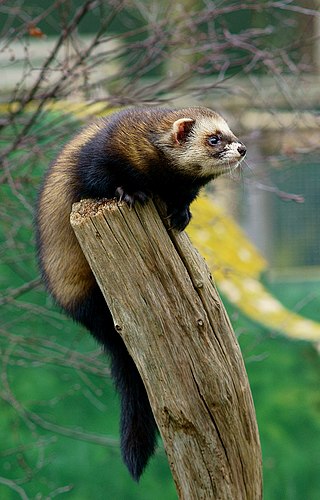
The European polecat, also known as the common polecat, black polecat and forest polecat, is a mustelid species native to western Eurasia and North Africa. It is of a generally dark brown colour, with a pale underbelly and a dark mask across the face. Occasionally, colour mutations including albinos, leucists, isabellinists, xanthochromists, amelanists and erythrists occur. It has a shorter, more compact body than other Mustela species, a more powerfully built skull and dentition, is less agile, and is well known for having the characteristic ability to secrete a particularly foul-smelling liquid to mark its territory.

The sable is a species of marten, a small omnivorous mammal primarily inhabiting the forest environments of Russia, from the Ural Mountains throughout Siberia, and northern Mongolia. Its habitat also borders eastern Kazakhstan, China, North Korea and Hokkaido, Japan.
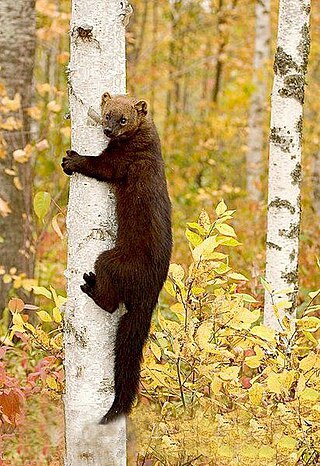
The fisher is a carnivorous mammal native to North America, a forest-dwelling creature whose range covers much of the boreal forest in Canada to the northern United States. It is a member of the mustelid family, and is in the monospecific genus Pekania. It is sometimes referred to as a fisher cat, although it is not a cat.

The European pine marten, also known as the pine marten, is a mustelid native to and widespread in most of Europe, Asia Minor, the Caucasus and parts of Iran, Iraq and Syria. It is listed as Least Concern on the IUCN Red List. It is less commonly also known as baum marten, or sweet marten.

The kuna was the currency of Croatia from 1994 until 2023. It was replaced by the euro in 2023. The kuna was subdivided into 100 lipa. It was issued by the Croatian National Bank and the coins were minted by the Croatian Mint.

The grivna was a currency as well as a measure of weight used in Kievan Rus' and other states in Eastern Europe from the 11th century.
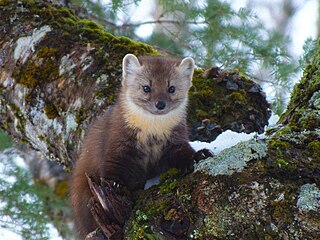
The American marten, also known as the American pine marten, is a species of North American mammal, a member of the family Mustelidae. The species is sometimes referred to as simply the pine marten. The name "pine marten" is derived from the common name of the distinct Eurasian species, Martes martes. Martes americana is found throughout Canada, Alaska, and parts of the northern United States. It is a long, slender-bodied weasel, with fur ranging from yellowish to brown to near black. It may be confused with the fisher, but the marten is lighter in color and smaller. Identification of the marten is further eased by a characteristic bib that is a distinctly different color than the body. Sexual dimorphism is pronounced, with males being much larger.

The beech marten, also known as the stone marten, house marten or white breasted marten, is a species of marten native to much of Europe and Central Asia, though it has established a feral population in North America. It is listed as Least Concern on the IUCN Red List on account of its wide distribution, its large population, and its presence in a number of protected areas. It is superficially similar to the European pine marten, but differs from it by its smaller size and habitat preferences. While the pine marten is a forest specialist, the beech marten is a more generalist and adaptable species, occurring in a number of open and forest habitats.

The Nilgiri marten is the only marten species native to southern India. It lives in the hills of the Nilgiris and parts of the Western Ghats. With only around a thousand members left it is listed as Vulnerable on the IUCN Red List.
Banovac, banski denar or banica is the name of a coin struck and used in Croatia between 1235 and 1384. The Latin name denarius banalis was derived from the words ban and denarius. The word ban is a title of nobility used in Croatia, and roughly translates as "viceroy", whereas denarius is Latin for coins minted by the Roman Empire.

The yellow-throated marten is a marten species native to the Himalayas, Southeast and East Asia. Its coat is bright yellow-golden, and its head and back are distinctly darker, blending together black, white, golden-yellow and brown. It is the second-largest marten in the Old World, after the Nilgiri marten, with its tail making up more than half its body length.

The kuna was the currency of the Independent State of Croatia from 1941 until 1945. The word kuna means "marten" in Croatian and the same name is used for the modern Croatian kuna currency, which was later replaced with the euro. This kuna was subdivided into 100 banica. It was preceded and replaced by the Yugoslav dinar.
A marten is a mammal in the family Mustelidae. Marten, Mårten, or Martén may also refer to:

Pekania is a genus of mustelid that contains a single living species, the fisher (Pekania pennanti). Formerly placed in the genus Martes, it was determined to be distinct enough to be placed within its own genus. A 2013 study also identified several fossil species formerly in Martes that are more closely related – and probably ancestral – to the fisher, moving them into Pekania as well.

The marturina or kunovina, referring to marten's fur, was a tax collected in the lands to the south of the Drava River in the medieval Kingdom of Hungary among the early Slavs. The term became important in the history of Croatian currency because it was the first of several instances of martens being used to symbolize money in Croatia.
This is a description of the current and historical currencies of Croatia, or historically used in the region. The currency of Croatia is the euro, in use since 2023.
The Croatian euro coins are a set of euro coins currently being minted by the Croatian Mint since July 2022. They are the official euro coins with the national motif of Croatia.









